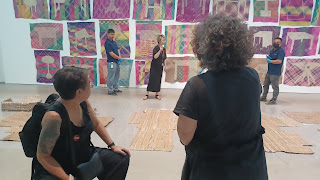I am not easily starstrucked. I can be in the same flight, elbow-to-elbow with the most famous rock band of my youth and be deadma about it.
[Eraserheads on flight PR511 to SG for their World Tour 2024. I was asleep the whole flight! True story.]
But when it comes to personally meeting people whose works I have encountered while learning about art or doing my own art, I’m the biggest fangirl!
[Not because I am pop culture snub. It just takes me more than sight to get warm and fuzzy. (Pun layers intended!) I’ll explain below.]
This year is kinna big fangirling year for me. In July I get to meet and spent time with what I call “textbooks” — those who I read for sound studies, sound art, and other related fields, Salome Voeglin, Cathy Lane, Angus Carlye, Mark Peter Wright… and the cherry on top Annea Lockwood! Earlier this November, I got to spend 5 days with the legendary Akio Suzuki and Hiromi Miyakita, as in hangout, not only work with them! And also Brandon LaBelle who I already worked with in 2023, but also one of those "textbooks". [Among others; too many more to mention]
My fangirling version is a bit different. Taking photo with them is not my expression of admiration. I take photo with people and/or places because I want to remember a particular moment.
It is when I take a mental snap, and keep that polaroid of memory in a shallow pocket, so I can keep going back to it... that’s my brand of fangirling.
A particular episode of fangirling happened this weekend (Nov21), that triggered my writing this blog.
I arrived in Singapore the same time as my old buddy, Sau Bin Yap— a curator and educator from KL. He was so kind to extend an invitation to go to SAM and meet with one of the curator’s June Yap.
Yee I-Lann, a Sabahan artist was also preparing for her solo exhibit in the GF gallery of SAM. I have known of I-Lann's work from my visits to SAM and reading materials (including catalogues) about Southeast Asian Art. I also know I-Lann as long-time partner of one of my most admired personality in non-mainstream music scene and archiving in Southeast Asia--- Joe Kidd of Ricecooker Archive. But I have not had the privilege of talking to her until that meeting in SAM.
I must have hearts coming out of my eyes, because I-Lann just started talking about her experience in working in the Filipinas Heritage Library in Manila, why she is with Silverlens Gallery management, and what she thinks about the politics of Philippines claim of Sabah. It was a quick meet because I-Lann and June has to take lunch and Sau Bin and I are headed to the 2 galleries on the 2F.
After an hour, June fetched us in Gallery 4, and brought us to where I-Lann was installing.
[I remember, while we were doing Media Art Kitchen, a decade ago, we discovered that curators get to have treats of visiting artist studios, having access to gallery storages, and actually getting previews of exhibits that are yet to be launched-- this was one of those visits.]
Upon entry to the Gallery, at the far end, I I immediately spotted the Sulu Series, which I-Lann aptly dubbed as her most popular work. I-Lann draw our attention to the horizon which draws a straight line between the series of canvasses; additionally saying that her photographs are pictures of sea and sky; that she is mapping the ocean, rather than mapping lands. She then talked about details of each work-- why it is there and what is the point of having it there. I particularly remember her saying that turtles have GPS while talking about the border of Pulau Silingan. She also talked about how Sulu is an apex point-- or a meeting point of nature and geopolitical borders.
We later walked towards batik kaen panjang that are still rolled, talking about how this type of textile is able to capture the role of women in the Sabahan society-- how batik is a woman’s historical document. She made a point by how dyeing, a technique used in making batik is a form of resistance.
Later we walked to her photo collages and banig (weaved mats). Here she talked about metaphors of power by the colonisers. Maps and surveillance were easy to relate to this point, but the table, being one of them is particularly curious. She explained how toppling the table is her expression of dissidence over the aggressive encroaching power.
(photo c/o SBY)
Weaved into the conversation, I-Lann made it clear that she is not doing historical work but a contemporary inquiry of why are we the way we are. This part of the conversation has way thicker sense, philosophically and practically. But I'll keep it abridged like this at the moment, until I have another conversation with her (wishful thinking), and more confident to actually talk about how these two creative attitudes are different (doing historical work VS contemporary art inquiry).
I write this blog not to replay our conversation with I-Lann, but more to highlight how conscious, how aware, how intentional the artist was towards her creation. My admiration towards I-Lann is not only because of the impact of her work, but more on her sense of responsibility as an artist. I find that it is a virtue that not every artist possess.
I am not sure when I will have the chance again to spend this kind of time with I-Lann. But for now, this is enough. This is one of those mental polaroids that I keep close to my heart.
[as hoped, I am now blogging about better things :]
More info about the exhibit on this link:




